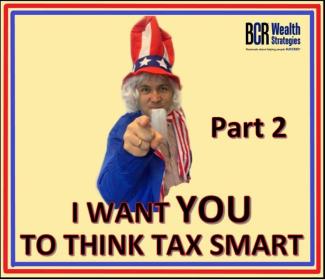
Tax Smart Investing Blog Pt2
Investors across the globe put their money into the markets wanting a positive experience. The decisions they make impact whether they have a positive experience or not. A mistake many of them make is focusing on things that they cannot control and ignoring things they can control. While I have never heard of someone trying to increase their tax burden, many investors do by not positioning their investments in a tax smart way (something you can control). Tax smart investing makes sense but instead of showing up as a positive number on a page (which most investors look for) it is hidden in the lack of tax burden that you don’t see.
As a firm that focuses on after tax return for our clients, Lindsay Birchfield and I were invited by Advice Chaser to give a seminar to their audience on some of the things to consider for tax smart investing. I must warn that this does involve some technical tax information that I have tried to simplify but can still be confusing.
In part 1 I discussed things to think of when designing a portfolio: Click here to read.
- The tax impact of the accounts you use
- The different tax impacts of asset classes
In this segment I will discuss things that need to be monitored for decisions in the moment:
- Tax loss harvesting- We should all understand that while long term investing has an expected positive return it does involve short term fluctuation that can cause the values to be lower than when you purchase them. When an investment’s value in your non-retirement account goes down below its purchase price you have an opportunity to harvest the loss and reduce your current year tax burden. Beware the Wash-Sale Rule, that will not allow you to recognize the loss if you purchase a “substantially identical” security within 30 days of the sale. To stay invested you need to not only have a fund you initially want to purchase in each asset class for your portfolio but an alternative that is not “substantially identical” to buy if a tax loss harvesting opportunity presents itself.
- Improving your cost basis when doing charitable giving- BCR® Wealth strongly believes in supporting our community and many of our clients do as well through donating their resources. For this reason, you can find many blog posts we have done over the years on ways to increase the tax benefits of donating. Whether you use a QCD, a Donor Advised Fund (DAF), or donate securities directly to a non-profit organization, there are many techniques to consider when making annual gifts. An important thing to consider is your overall financial giving plan. Most of these techniques benefit from taking the securities that have appreciated significantly and giving them while investing the cash you would have given into the exact same security at a higher cost basis. Don’t make the mistake of donating more than you can for your long-term security since it is not affecting your current cash flow.
The 4 tips discussed in this series are just the beginning of managing a tax smart portfolio. Hopefully as you read this you realized a significant key to tax smart investing success is designing a financial plan that incorporates your household’s lifetime goals and then designing a single household portfolio to incorporate all your accounts and investments to achieve your goals. Often, we find that the public and professionals that are not focused on tax smart investing tend to invest different accounts towards different goals preventing many of the tax smart investing I mentioned. While I have not found the perfect portfolio that had the same proportions available to invest in each account, the more you focus on positioning your investments and monitoring them for opportunities, the better chance you have to increase your family’s after-tax net worth.
Designing a tax smart household portfolio to reach all your goals
To view the full seminar replay, go here ADVICE CHASER TAX SMART INVESTING WITH BCR® WEALTH’S MARSHALL RATHMELL AND LINDSAY BIRCHFIELD

